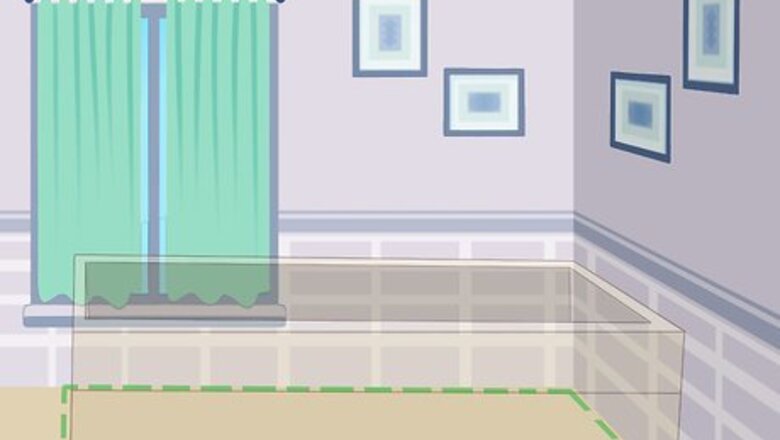
views
Choosing a Location

Find space on the lower floors of your home for the pond. Keep in mind that indoor ponds are very heavy. The floor underneath your pond has to bear the weight of all the water the pond holds. Ponds belong on the lower levels of homes, such as in the basement, to prevent flooring from collapsing underneath it. Leaking ponds are also an issue. The water can seep into the floor, rotting wooden support beams. The best place for a pond is on top of stable ground, such as over a concrete foundation.

Find a spot that is safe from any small children or pets in your home. If you can, place the pond behind a lockable door to prevent anyone from accessing the pond when you're not around. If this isn't an option, building barriers around your pond helps. Surround the pond's space with plywood barriers, for instance, that restrict access to the pond. Plan your pond's depth carefully. For instance, making the pond wide and shallow helps prevent accidents, but small children and pets will be able to climb in the pond or drink from it. Building a deeper pond with taller sides is good for preventing children or pets from climbing into the pond, but the pond will be less accessible.
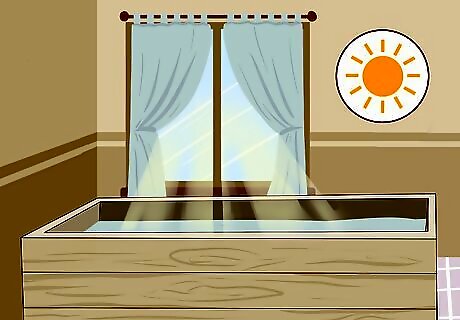
Place the pond in partial sunlight if it will contain plants or fish. Ponds need a balance of shade and sunlight in order to become a healthy habitat for living things. Put your pond near a window, if possible, so it gets about 4 to 6 hours of sunlight per day. Avoid areas that receive more direct sunlight than this, since the light may warm the water too much and facilitate algae growth. Choosing a stable spot is more important than finding an area of sunlight. If your pond doesn't get enough light, purchase some LED or fluorescent pond lights to simulate sunlight.
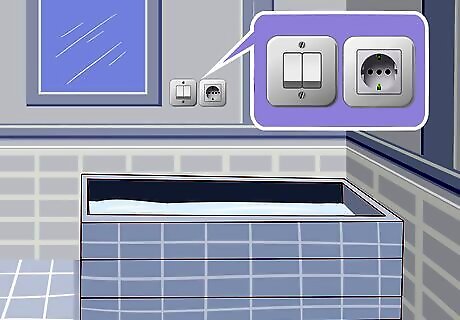
Find an area close to an electrical outlet to power lights and pumps. Most ponds depend heavily on electrical components to create a healthy environment for plants and animals. To raise koi, for instance, you may need pond lights, an aquarium heater, and a pump and filter system. Build the pond near an outlet for easy access to your home's electricity even if you're unsure you will need it. Build the pond so the electrical outlet is a short distance away, easy to access without lots of extension cords.

Make the pond near a fan to disperse heat and moisture. The water from the pond affects the atmosphere of your home in more ways than one. A good ceiling fan is a way to compensate for these changes. Having a window nearby to open also helps. Releasing the extra heat and moisture reduces the chances of rotting wood supports in addition to making your home feel more comfortable. If you don't have a fan nearby, install a dehumidifier to eliminate the extra moisture the pond releases into the air.
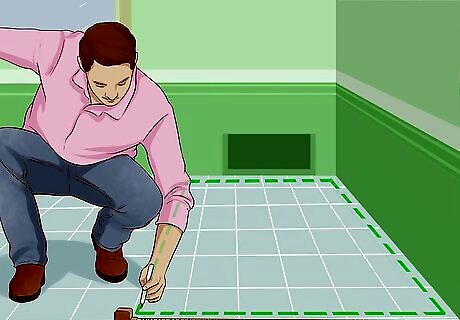
Measure out the space you have available for the pond. Once you have found a good spot for your pond, break out your tape measure. Determine how long, wide, and deep your pond will be. An average home floor is capable of holding about 40 lb (18 kg) per 1 sq ft (0.093 m), or a pond about 18 in (46 cm) deep. To determine how many gallons of water your pond will hold, measure its length, width, and height in feet. Multiply all the measurements together, then multiply that by 7.5. Make the pond big enough to hold whatever plants and fish you wish to keep. Mature koi, for example, require about 50 gallons (190 L) of water each. Square or rectangular ponds are the simplest to construct. Ponds can also be made kidney bean-shaped, which looks more natural.
Creating the Pond's Exterior
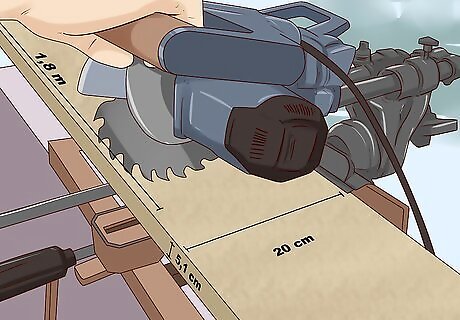
Cut the wood needed to construct the pond walls. Build an inexpensive pond out of plywood and construction grade lumber like pine. Cut the wood yourself with table saw while wearing safety goggles, ear protection, and a dust mask. Alternatively, many home improvement stores will cut wood to your specifications. To make a 500 US gal (1,900 L) pool about 6 × 6 × 2 ft (1.83 × 1.83 × 0.61 m): Cut 12 construction grade boards to be 6 ft (1.8 m) long, 8 in (20 cm) wide, and 2 in (5.1 cm) thick. Get 4 deck boards that are the same size as the construction grade boards. Make 4 plywood boards 8 ft (2.4 m) long, 4 ft (1.2 m) wide, and ⁄2 in (1.3 cm) thick. If you don't wish to make a wood pond, concrete blocks are another option for a stable pond.
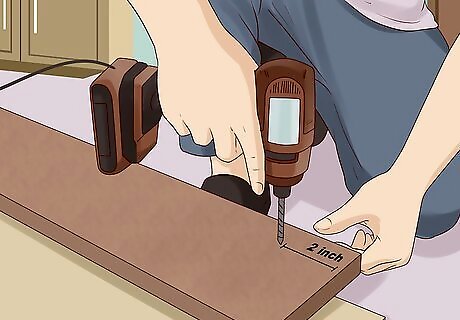
Predrill into the ends of boards forming the pond's perimeter. Measure 2 in (5.1 cm) from the ends of the boards. Make a column of holes, leaving 2 in (5.1 cm) between them. For the 6 × 6 × 2 ft (1.83 × 1.83 × 0.61 m) pond, use a ⁄64 in (0.12 cm) drill bit to create the holes. Drill the holes into 4 of the boards Pre-drilling the holes prevents the boards from cracking when you screw them together. If you're making a concrete pond, gather a bunch of same-sized blocks and lay out the first layer in the desired shape and size.

Screw the boards together to form the pond's exterior. Choose 2 each of the drilled and undrilled construction boards. Rest the longer side of each board on the ground, arranging the boards to form a square “ring.” Make sure the boards are flush with the pre-drilled holes on the outside edge of the ring. Repeat this with the remaining boards to create 3 separate rings. For the 6 × 6 × 2 ft (1.83 × 1.83 × 0.61 m) pond, you will need 3 in (7.6 cm) screws and an electric screwdriver. For a concrete pond, join 2 layers of blocks together with mortar. Spread a layer of mortar on top of the first row of blocks, add the second row of blocks, and let it dry for at least 24 hours. Repeat the process until the blocks reach the desired height.
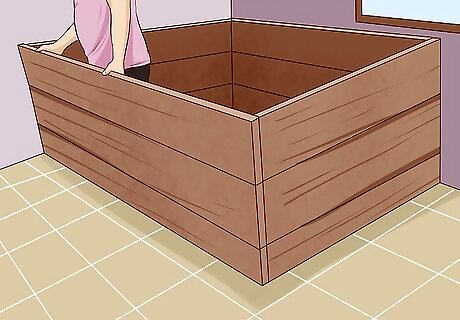
Stack the boards to create the pond's walls. After connecting the boards together, you will have 3 square rings. Place them on top of one another. Make sure they are all flush. You don't need to connect the rings together yet. Try pushing on the boards. If they wobble, they aren't attached well, leaving your pond wall vulnerable. Tighten the screws in place until the boards are secure and the rings feel stable. To make a concrete pond, spread another layer of mortar on top of the second row of blocks. Fit another layer of blocks in place, then let the mortar dry.
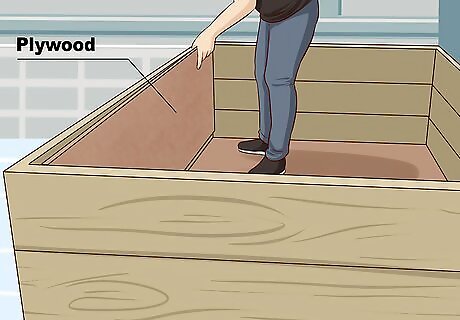
Install a plywood lining to the inside part of the pond. Move the plywood inside the rings, resting them firmly against the boards. Cut the plywood to size as needed so it fits flush with the top edges of the pond walls. Attach the plywood with screws to create a protective lining that holds the other boards together. For the 6 × 6 × 2 ft (1.83 × 1.83 × 0.61 m) pond, use a series of 1 in (2.5 cm) screws. Space the screws out 12 in (30 cm) along the plywood's length and about every 16 in (41 cm) down its width. When you're done, the boards will be attached to the walls by 3 rows of screws. You do not need plywood for a concrete pond. If you wish to strengthen the pond, slide reinforcing rods down through each set of blocks.
Constructing the Pond's Interior
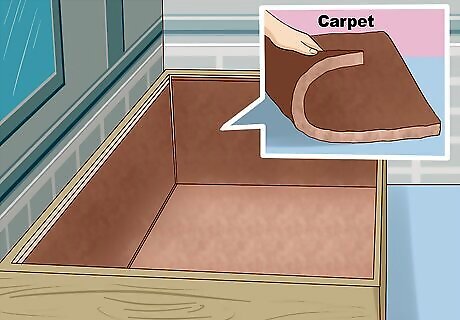
Pad the pond interior with soft material such as carpet. Take advantage of recycled carpeting for an inexpensive way to insulate the pond. Cut the carpeting to size with a sharp utility knife. Fit it over the floor and against the inside walls of the pond. Spread some carpet glue adhesive with a trowel and press the carpet tightly against the wood. Make sure the carpet rests flat against the walls. Don't leave any gaps exposing the wood. Avoid stapling the carpet if possible. The staples will rub up against the pond liner, possibly breaking it. If you don't have carpeting, get a different insulating material. Insulating Styrofoam is also easy to glue to the wood. Some people even create thick layers of insulation out of old newspapers.

Measure and cut the pool liner to fit inside the pond. Get a 45 mil EPDM rubber liner and spread it out over your floor. The liner needs to be big enough to hang over the pond's walls by about 3 in (7.6 cm). For the wooden pond, choose a liner that's at least 19 ft (5.8 m) long per side so it fits snugly inside the pond. Pond liners are available at many home improvement stores. If the store doesn't have a liner big enough for your pond, consider wrapping the wood in a bunch of smaller liners, such as 10 ft × 10 ft (3.0 m × 3.0 m) ones. Always cut the liner a little longer than your measurements so the ends fold over the top of the pond. The 45 mil rating indicates the liner's thickness, which is needed to hold up under the weight of the water. Make sure you don't pick up a thin liner by accident.
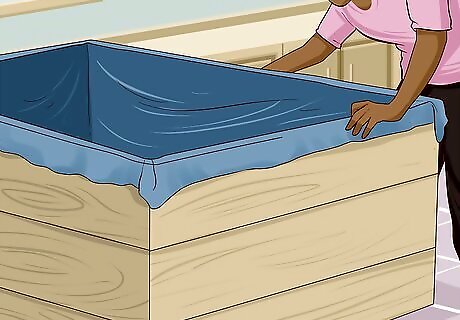
Place the liner in the pool and fold its ends over the walls. Drop the liner into the center of the pond, bringing the edges over the walls. Flatten the liner as much as possible so it rests up against the pond's floor and walls. Try to get it to fit as tightly against the corners as possible. Any wrinkles in the liner may turn into air bubbles later. The liner may break in these spots. Pull the liner to eliminate any wrinkles and air pockets before finishing the installation. Take the time to test the liner for holes by pouring about 1 in (2.5 cm) of water into it. If you see any leaks, patch them up with a square of liner and duct tape or replace the entire liner.
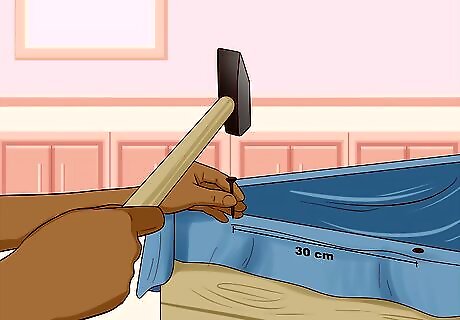
Tack the liner in place with 3 in (7.6 cm) roofing nails. Place the nails about every 12 in (30 cm) along the tops of the walls. Hammer them down carefully to secure the liner in place. As long as the liner is tight against the wood, it won't stretch and leak later. The liner can also be weighed down with rocks (or another layer of concrete blocks if you aren't using wood) or lightly pinned in place. That way, you reduce the risk of big punctures that need to be fixed.
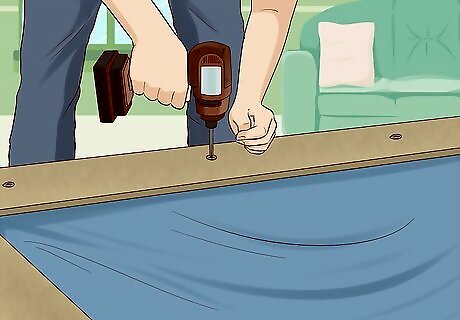
Screw the deck boards in place on top of the pond's walls. Press the deck boards tightly against the pond liner. Position 3 in (7.6 cm) screws every 2 ft (0.61 m) along the outer edge of each board. Then, use an electric screwdriver to fasten the boards in place. The pond liner will be sandwiched between the deck boards and the top of the pond walls, holding it in place. Keep the screws about 2 in (5.1 cm) from the edges of the boards so they stay strong. The deck boards hide the liner. Piling rocks or concrete blocks around the pool's walls is another way to mask the liner and may be a better option depending on the pond you build.
Filling the Pond
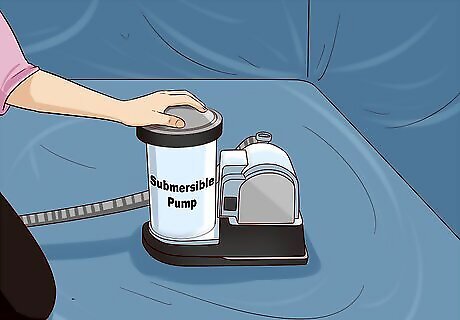
Install a submersible pump and filter system in the center of the pond. The submersible pump prevents the water from becoming stagnant. It forces water to circulate in the pond while the filter component removes harmful debris. Set the pump down, running its line to the nearest outlet. Plug it in and wait until you add water to the tank to run it. Calculate the pond's water volume by multiplying its length, width, and height together. Multiply that by 7.5 to get the number of gallons of water your pond holds. Pumps are rated by how much water they circulate in an hour. Choose a pump rated for at least half your pond size, such as by getting a 500 US gal (1,900 L) per hour pump for a 1,000 US gal (3,800 L) pond. Also, make sure the filter system dechlorinates water. If it doesn't, install a separate dechlorinator in order to keep the water safe for pond plants and fish.
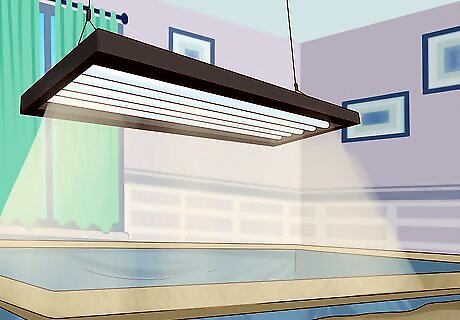
Set up a fluorescent light if your pond will house plants or fish. Many ponds end up in basements and other spots that don't get a lot of light. Adding a light source helps keep the pond healthy. Install a light bulb or hang a light fixture over the pond so any living creatures in it receive plenty of light. Research what your pond dwellers need. Most fish and plants do well with full spectrum fluorescent lights. Some species may have special lighting needs.

Use an aquarium heater to warm the water if it gets too cold. Find a heater rated for the size of your pond. Then, drop the heater into an isolated corner of the pond near a wall outlet. After plugging in the heater, continue testing the water to see how effective the heater is. Whether or not you need a heater depends on the temperature of your environment. Having a heater is crucial for many basement ponds. Koi, for instance, require a water temperature between 52 and 60 °F (11 and 16 °C).
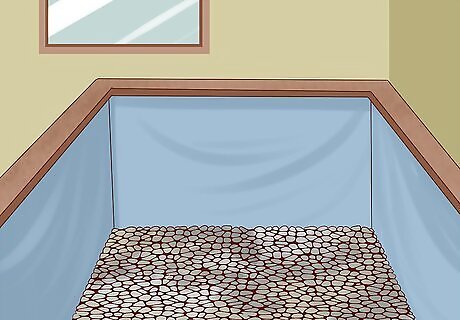
Cover the pond's bottom with a layer of sand or gravel. These substrates hide the liner, protect it from damage, and make your pond more aesthetically pleasing. Get enough bags or mortar sand or gravel to form a layer between 1 to 2 in (2.5 to 5.1 cm) thick. Pour it directly into the pond on top of the liner. Sand cushions the liner from damage, but it also tends to make the water look a little cloudy. Gravel can be sharp and heavy, so pour it into the pond with caution. Once it's in the pond, it forms a smooth bottom that doesn't affect the water.
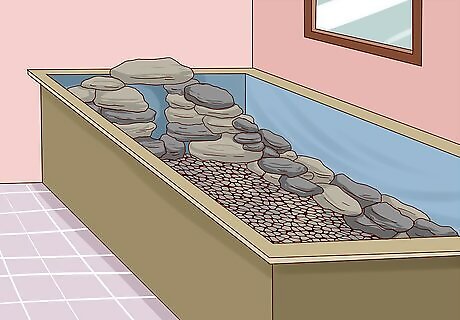
Build up the sides of your pond by stacking river stones. Purchase some larger river rocks and stones from your local home improvement store. Stack them against the sides of the pond. Push the bottom stones into the sand or gravel a little bit to fit them in place. These stones conceal the rest of the liner. Sandbags are another useful way to hide the liner. Lay the sandbags horizontally around the pond's edge, stacking them to create ridges. Then, cover all of them with stones. The sandbags reduce the amount of stones you need while creating a buffer between the stones and the liner. If you don't cap your pond's walls with deck boards, get some copestones to fit on top of the walls.
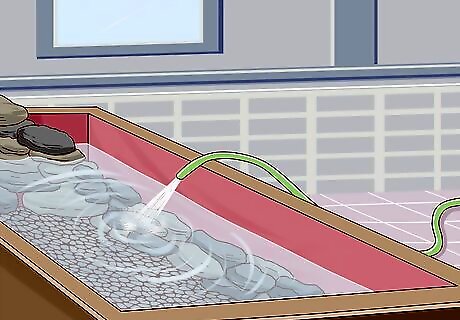
Fill the pond by running a hose from the faucet. Set the end of the hose in the pond and release the water. Let the water flow until it's about 3 in (7.6 cm) from the top of the walls. Make sure the water isn't leaking out from the pond before you finish filling it. Put a little bit of water in at first to check for leaks. Notice any spots where the water appears to drain and patch the liner as needed before filling the pond.

Introduce any fish and plants you wish to add to the pond. Gather up some pond plants and fish like koi. To install a plant, reach into the water and push the plant's base into the sand or gravel. Scatter plants around to give your pond a consistent aesthetic. Then, drop any pond fish in and watch them enjoy their new home! Research plants and fish before adding them. Each species has different needs. Some plants like shallow water, for instance, while others do better in deeper, darker parts of the pond. Marginal pond plants are a great option.















Comments
0 comment